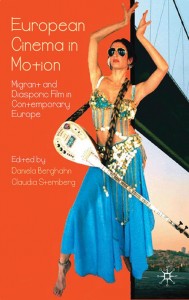European Cinema in Motion Migrant and Diasporic Film in Contemporary Europe by Daniela Berghahn and Claudia Sternberg (eds) (Palgrave Macmillan, 2014), 321 pages, ISBN: 978-1137390196 (paperback), £19.99
About the reviewer: Arne Saeys is a social and cultural anthropologist. His publications include Imag(in)ed Diversity. Migration in European Cinema (2013).
This book is the paperback edition of a hardcover originally published in 2010. At the time, European Cinema in Motion was one of the few books entirely dedicated to the under-researched phenomenon of migrant and diasporic cinema in Europe. Over the past few years, more publications have followed dealing with transnational, postcolonial, multilingual and world cinemas. Besides these general and theoretical approaches, some authors have directed their attention to specific diasporic cinemas like Black and Asian British, Maghrebi French and Turkish German cinemas. While all these publications contributed to the understanding of migrant and diasporic cinema, European Cinema in Motion remains a unique collection of essays that combines theoretical insights with detailed analyses of European films from a broad geographical perspective ranging from the UK, Germany, France, Spain, Italy and Greece to Russia and Central Asia. The common thread among most chapters is the representation of migrants in European cinema since the 1980s with special attention to films made by migrant and diasporic filmmakers.
 In the first chapter, Berghahn and Sternberg theorise migrant and diasporic cinema in terms of memory and generations. First-generation migrant and second-generation diasporic filmmakers would be able to activate respectively memorial and post-memorial connections to the migratory past, whereas non-migrant/non-diasporic filmmakers draw on a 'prosthetic memory' that is not circumscribed by any particular group identity. Berghahn and Sternberg claim that migrant and diasporic cinema marks a World Cinema turn in European cinema, translating cultural hybridity into a new aesthetic paradigm.
In the first chapter, Berghahn and Sternberg theorise migrant and diasporic cinema in terms of memory and generations. First-generation migrant and second-generation diasporic filmmakers would be able to activate respectively memorial and post-memorial connections to the migratory past, whereas non-migrant/non-diasporic filmmakers draw on a 'prosthetic memory' that is not circumscribed by any particular group identity. Berghahn and Sternberg claim that migrant and diasporic cinema marks a World Cinema turn in European cinema, translating cultural hybridity into a new aesthetic paradigm.
In the second chapter, Dina Iordanova looks at post-communist migrations from the perspective of postcolonial theory. She draws the attention to a category of transnationally mobile filmmakers who are neither migrants nor diasporas but who move on a project-by-project basis to wherever the best funding and production opportunities arise. In the third chapter, Anne Jäckel concludes that most funding initiatives and policies in Europe do not recognise migrant and diasporic cinema as a separate category of cinema.
Each of the other chapters investigates more in detail migration and diaspora issues in relation to specific national cinemas. Birgit Beumers explores nostalgia as the longing for a 'homeland of the past' in post-Soviet Russian and Central Asian films. Encarnación Gutiérrez Rodríguez interprets the representation of intimate relations between migrants and citizens as examples of transculturation, revealing the politics of cohabitation and domination in Spain and Germany. Sarita Malik describes how British Asian Cinema achieved commercial and transnational success, while Black British cinema remained constrained and locally rooted. Isabel Santaolalla draws the attention to the sexualised corporeality of suffering migrant bodies in Spanish, Italian and Greek films. Carrie Tarr argues that diasporic women filmmakers portraying strong and active females counteract the dominant imagery of diasporic women as passive victims. James Williams discusses the representation of queer migrants confronted with the double threat of racism and homophobia. Daniela Berghahn describes the diasporic youth film as a coming-of-age film dealing with the search for ethnic and cultural belonging. Deniz Göktürk argues that the celebration of musical hybridity challenges any nation-based understanding of music, film and culture in general. In the last chapter, Claudia Sternberg claims that films and scenes about cinema-going enable us to reflect on migrants not only as objects of stereotypical representation, but also as consumers, critics and producers of media. In an epilogue, film professional Gareth Jones concludes that migrant and diasporic cinema should not be seen as a genre but rather as a thematic concern in contemporary European cinema.
Although it is not always easy to find coherence between the different chapters in this volume, the rich variety of approaches is also the strength of the book as the editors succeeded in capturing the lively debate on the representation of migrants in contemporary European cinema.
Arne Saeys